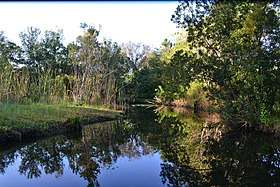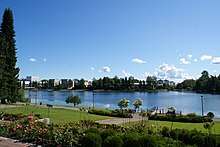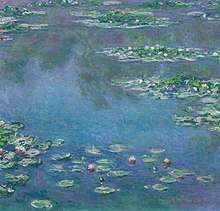Pond
A pond is an area filled with water, either natural or artificial, that is smaller than a lake.[1] It may arise naturally in floodplains as part of a river system, or be a somewhat isolated depression (such as a kettle, vernal pool, or prairie pothole). It may contain shallow water with aquatic plants and animals.[2]


Factors that affect the type of life found in a pond include depth and duration of water level, nutrients, shade, presence or absence of inlets and outlets, effects of grazing animals, and salinity.[3]
Ponds are frequently man-made, or expanded beyond their original depth and bounds. Among their many uses, ponds provide water for agriculture and livestock, aid in habitat restoration, serve as fish hatcheries, are components of landscape architecture, may store thermal energy as solar ponds, and treat wastewater as treatment ponds.
Ponds may be freshwater, saltwater, or brackish.
Technical definitions

The technical distinction between a pond and a lake has not been universally standardized. Limnologists and freshwater biologists have proposed formal definitions for pond, in part to include 'bodies of water where light penetrates to the bottom of the waterbody,' 'bodies of water shallow enough for rooted water plants to grow throughout,' and 'bodies of water which lack wave action on the shoreline.' Each of these definitions has met with resistance or disapproval, as the defining characteristics are each difficult to measure or verify. Accordingly, some organizations and researchers have settled on technical definitions of pond and lake that rely on size alone.[4]
Even among organizations and researchers who distinguish lakes from ponds by size alone, there is no universally recognised standard for the maximum size of a pond. The international Ramsar wetland convention sets the upper limit for pond size as 8 hectares (80,000 m2; 20 acres).[5] Researchers for the British charity Pond Conservation (now called Freshwater Habitats Trust) have defined a pond to be 'a man-made or natural waterbody that is between 1 m2 (0.00010 hectares; 0.00025 acres) and 20,000 m2 (2.0 hectares; 4.9 acres) in area, which holds water for four months of the year or more.'[4] Other European biologists have set the upper size limit at 5 hectares (50,000 m2; 12 acres).[6]
In practice, a body of water is called a pond or a lake on an individual basis, as conventions change from place to place and over time. In North America, even larger bodies of water have been called ponds; for example, Crystal Lake at 33 acres (130,000 m2; 13 ha), Walden Pond in Concord, Massachusetts at 61 acres (250,000 m2; 25 ha), and nearby Spot Pond at 340 acres (140 ha). There are numerous examples in other states, where bodies of water less than 10 acres (40,000 m2; 4.0 ha) are being called lakes. As the case of Crystal Lake shows, marketing purposes can sometimes be the driving factor behind the categorization.[7]
Formation

Ponds can result from a wide range of natural processes. Any depression in the ground which collects and retains a sufficient amount of precipitation can be considered a pond, and such depressions can be formed by a variety of geological and ecological events.
Rivers often leave behind ponds in natural floodplains after spring flooding, and these can be very important to breeding fish, particularly in large river systems like the Amazon.[8] Retreating glaciers can leave behind landscapes filled with small depressions, each developing its own pond; an example is the Prairie Pothole Region of North America.[9] Many areas of landscape contain small depressions which form temporary ponds after spring snow melts, or during rainy seasons; these are called vernal ponds, and may be important sites for amphibian breeding.[10]
Some ponds are created by animals. Beaver ponds are the best-known example, but alligators also excavate ponds as well.[3]
In landscapes with organic soils, fires can also create depressions during periods of drought; these become open water when normal water levels return.[11]
Characteristics

A defining feature of a pond is the presence of standing water, which provides habitat for wetland plants and animals. Familiar examples might include water lilies, frogs, turtles, and herons. Often, the entire margin of the pond is fringed by wetland, and these wetlands support the aquatic food web, provide shelter for wildlife, and stabilize the shore of the pond. Some grazing animals like geese and muskrats consume the wetland plants directly as a source of food. In many other cases, however, the pond plants fall into the water and decay. Many invertebrates then feed on the decaying plants, and these invertebrates provide food for wetland species including fish, dragonflies, and herons. The open water may allow algae to grow, and these algae may support yet another food web that includes aquatic insects and minnows. A pond, therefore, may have combinations of three different food webs, one based on larger plants, one based upon decayed plants, and one based upon algae. Hence, ponds often have many different animal species using the wide array of food sources. They, therefore, provide an important source of biological diversity in landscapes.
Vernal ponds are ponds which dry up for part of the year. They are so called because they are typically at their peak depth in the spring (the meaning of "vernal" comes form the Latin word for spring). Naturally occurring vernal ponds do not usually have fish. The absence of fish is a very important characteristic since it provides amphibians with breeding locations free from predation by fish. Hence, introducing fish to a pond can have seriously detrimental consequences. In some parts of the world, such as California, the vernal ponds have rare and endangered plant species. On the coastal plain, they provide habitat for endangered frogs such as the Mississippi Gopher Frog.[3]
Conservation and management
Ponds, being small, are easily disrupted by human activity, such as hikers. Drainage of ponds is a frequent problem in agricultural areas, such as in the prairie potholes of North America. Although ponds are a useful source of water for cattle, overgrazing and wading can turn a pond into a muddy hole. Nutrient sources such as fertilized pastures, human sewage, and even lawn fertilizer can cause explosive growth of algae and the loss of rooted plants and many other aquatic species. Roads near ponds can kill large numbers of amphibians and turtles that may migrate to and from the pond as part of their annual breeding cycle. Many well-intentioned people introduce fish to ponds, being unaware that some species may eat aquatic plants, stir up sediment, and eat the young of amphibians and many other invertebrate species. The gentle slope of land into ponds also provides an expanse of habitat for wetland plants and wet meadows. The construction of retaining walls, or lawns, can severely degrade the life in a pond.
In landscapes where ponds are artificially constructed, they are done so to provide wildlife viewing opportunities, to treat wastewater, or for aesthetic purposes, such as part of a golf course. The design of a pond determines how productive it will be for wildlife. In general, gently sloping shorelines with broad expanses of wetland plants not only provide the best conditions for wildlife, but they help protect water quality from sources in the surrounding landscapes. It is also beneficial to allow water levels to fall each year during drier periods. Roads and houses should be kept as far away as possible.[12]
Another important way to add ponds back into landscapes is to restore rivers so that they can flood and meander to create large numbers of natural ponds, including vernal pools and wetlands, in river valleys.[13]
Nomenclature
In origin, a pond is a variant form of the word pound, meaning a confining enclosure.[14] As straying cattle are enclosed in a pound so water is enclosed in a pond. In earlier times, ponds were artificial and utilitarian, as stew ponds, mill ponds and so on. The significance of this feature seems, in some cases, to have been lost when the word was carried abroad with emigrants. In the United States, natural pools are often called ponds. Ponds for a specific purpose keep the adjective, such as "stock pond", used for watering livestock.
Pond usually implies a quite small body of water, generally smaller than one would require a boat to cross. Another definition is that a pond is a body of water where even its deepest areas are reached by sunlight or where a human can walk across the entire body of water without being submerged. In some dialects of English, pond normally refers to small artificially created bodies of water.

Some regions of the United States define a pond as a body of water with a surface area of less than 10 acres (4.0 ha). Minnesota, known as the "land of 10,000 lakes", is commonly said to distinguish lakes from ponds, bogs and other water features by this definition,[15] but also says that a lake is distinguished primarily by wave action reaching the shore.[16]
The term is also used for temporary accumulation of water from surface runoff (ponded water).
There are various regional names for naturally occurring ponds. In Scotland, one of the terms is lochan, which may also apply to a large body of water such as a lake. In North American prairies, they may be termed playas.[17]
Uses
_5of6.jpg)
Ponds are used for the provision of fish and other wildlife including waterfowl, which is a source of food for humans. Pollutants entering ponds are often substantially mitigated by the natural sedimentation and biological activities within the water body. Ponds are also a major contributor to local ecosystem richness and diversity for both plants and animals.[18]
In the Indian subcontinent, Hindu temples usually have a pond nearby so that pilgrims can take baths. These ponds are considered sacred.
In medieval times in Europe, it was typical for many monastery and castles (small, partly self-sufficient communities) to have fish ponds. These are still common in Europe and in East Asia (notably Japan), where koi may be kept.
Waste stabilization ponds are used as a low-cost method for wastewater treatment.
In agriculture, treatment ponds may reduce nutrients released downstream from the pond. They may also provide irrigation reservoirs at times of drought.
Examples
Some notable ponds are:
- Big Pond, Nova Scotia
- Walden Pond, Massachusetts, United States — associated with Henry David Thoreau
- Christian Pond, Wyoming, United States
- Hampstead Ponds, London
- Rožmberk Pond, Czech Republic
See also
- Cypress dome – A swamp dominated by pond or bald cypress
- Treatment pond
- Water garden
References
- "Definition of POND". www.merriam-webster.com.
- John Clegg (1986). The New Observer's Book of Pond Life. Frederick Warne. p. 460. ISBN 978-0723233381.
- Paul A. Keddy (2010). Wetland Ecology: Principles and Conservation. Cambridge University Press. ISBN 978-0521739672.
- Jeremy Biggs, Penny Williams, Mericia Whitfield, Pascale Nicolet, Anita Weatherby (2 November 2005). "15 years of pond assessment in Britain: results and lessons learned from the work of Pond Conservation (now called Freshwater Habitats Trust)". Aquatic Conservation: Marine and Freshwater Ecosystems. 15 (6): 693–714. doi:10.1002/aqc.745.CS1 maint: multiple names: authors list (link)
- "Information Sheet on Ramsar Wetlands (RIS)". Ramsar Convention on Wetlands. Archived from the original on 4 March 2009. Retrieved 2 March 2013.
- R. Céréghino; J. Biggs; B. Oertli; S. Declerck (February 2008). "The ecology of European ponds: defining the characteristics of a neglected freshwater habitat". Hydrobiologia. 597 (1): 1–6. doi:10.1007/s10750-007-9225-8.
- "Newton Park and Conservation Lands: Crystal Lake". Newton Conservators. Retrieved 2 March 2013.
- Ro McConnell (1975). Fish Communities in Tropical Freshwaters: Their Distribution, Ecology, and Evolution. Longman. ISBN 978-0582443488.
- Arnoud van der Valk (1989). Northern Prairie Wetlands. Iowa State University. ISBN 978-0813800370.
- Aram J. K. Calhoun; Phillip G. DeMaynadier (2008). Science and Conservation of Vernal Pools in Northeastern North America. CRC Press. ISBN 978-1420005394.
- Steven M. Davis (1994). "Synthesis: vegetation pattern and process in the Everglades ecosystem". Everglades: The Ecosystem and its Restoration. St. Lucie Press. pp. 445–60. ISBN 978-0963403025.
- Canadian Wildlife Service (2004). How Much Habitat is Enough? A Framework for Guiding Habitat Rehabilitation in Great Lakes Areas of Concern (2nd ed.). Canadian Wildlife Service. ISBN 978-0662265771.
- K. S. Richards (2003). The Flooded Forest: Guidance for Policy Makers and River Managers in Europe on the Restoration of Floodplain Forests. FLOBAR2 Project.
- "Pond". Oxford English Dictionary. Retrieved 2 March 2013.
- "Lakes, rivers, and wetlands facts". Minnesota Department of Natural Resources. Retrieved 2 March 2013.
- "Frequently asked questions about lakes". Minnesota Department of Natural Resources. Retrieved 2 March 2013.
- Loren M. Smith (2003). Playas of the Great Plains. University of Texas Press. ISBN 978-0292743687.
- "Freshwater ecosystems:publisher=Forest Research". Retrieved 12 October 2016.
Further reading
- Clegg, J. (1986). Observer's Book of Pond Life. Frederick Warne, London. 460p.
- Hughes, F.M.R. (ed.). (2003). The Flooded Forest: Guidance for policy makers and river managers in Europe on the restoration of floodplain forests. FLOBAR2, Department of Geography, University of Cambridge, Cambridge, UK. 96 p.
- Environment Canada. (2004). How Much Habitat is Enough? A Framework for Guiding Habitat Rehabilitation in Great Lakes Areas of Concern. 2nd ed. 81 p.
- Keddy, P.A. (2010). Wetland Ecology: Principles and Conservation (2nd edition). Cambridge University Press, Cambridge, UK. 497 p.
- Herda DJ (2008) Zen & the Art of Pond Building Sterling Publishing Company. ISBN 978-1-4027-4274-3.
- W.H. MacKenzie and J.R. Moran (2004). Wetlands of British Columbia: A Guide to Identification. Ministry of Forests, Land Management Handbook 52.
External links
| Wikiquote has quotations related to: Pond |

